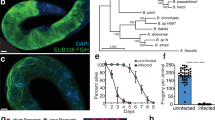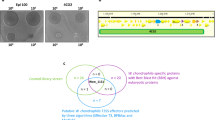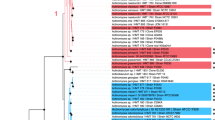Abstract
Dictyostelium amoebae have been used as a host model to measure virulence of a wide range of bacterial pathogens. The simple protocol described here takes advantage of the ability of Dictyostelium to grow and form plaques on a lawn of nonpathogenic bacteria but not on virulent bacteria. This assay can be modulated to measure the virulence of different bacterial pathogens. By adjusting various parameters such as cell numbers or media, a more quantitative measure of bacterial virulence can also be obtained. The entire procedure takes about 5 h to compete, and up to 2 further weeks may be required for plaques to form on the bacterial lawn.
This is a preview of subscription content, access via your institution
Access options
Subscribe to this journal
Receive 12 print issues and online access
$259.00 per year
only $21.58 per issue
Buy this article
- Purchase on Springer Link
- Instant access to full article PDF
Prices may be subject to local taxes which are calculated during checkout


Similar content being viewed by others
References
Casadevall, A. & Pirofski, L.A. Host–pathogen interactions: redefining the basic concepts of virulence and pathogenicity. Infect. Immun. 67, 3703 (1999).
Hilbi, H., Weber, S.S., Ragaz, C., Nyfeler, Y. & Urwyler, S. Environmental predators as models for bacterial pathogenesis. Environ. Microbiol. 9, 563 (2007).
Kurz, C.L. & Ewbank, J.J. Infection in a dish: high-throughput analyses of bacterial pathogenesis. Curr. Opin. Microbiol. 10, 10 (2007).
Cosson, P. & Soldati, T. Eat, kill or die: when amoeba meets bacteria, Curr. Opin. Microbiol. 11, 271–276 (2008).
Fey, P., Kowal, A.S., Gaudet, P., Pilcher, K.E. & Chisholm, R. Protocols for growth and development of Dictyostelium discoideum. Nat. Protoc. 2, 1307 (2007).
Eichinger, L. et al. The genome of the social amoeba Dictyostelium discoideum. Nature 435, 43 (2005).
Sussman, R. & Sussman, M. Cultivation of Dictyostelium discoideum in axenic medium. Biochem. Biophys. Res. Commun. 29, 53 (1967).
Watts, D.J. & Ashworth, J.M. Growth of myxameobae of the cellular slime mould Dictyostelium discoideum in axenic culture. Biochem. J. 119, 171 (1970).
Cosson, P. et al. Pseudomonas aeruginosa virulence analyzed in a Dictyostelium discoideum host system. J. Bacteriol. 184, 3027 (2002).
Alibaud, L. et al. Pseudomonas aeruginosa virulence genes identified in a Dictyostelium host model. Cell Microbiol. 10, 729 (2008).
Froquet, R. et al. Alternative host model to evaluate Aeromonas virulence. Appl. Environ. Microbiol. 73, 5657 (2007).
Kalima, P., Masterton, R.G., Roddie, P.H. & Thomas, A.E. Lactobacillus rhamnosus infection in a child following bone marrow transplant. J. Infect. 32, 165 (1996).
Benghezal, M. et al. Specific host genes required for the killing of Klebsiella bacteria by phagocytes. Cell Microbiol. 8, 139 (2006).
Franke, J. & Kessin, R. A defined minimal medium for axenic strains of Dictyostelium discoideum. Proc. Natl. Acad. Sci. USA 74, 2157 (1977).
Cornillon, S. et al. Phg1p is a nine-transmembrane protein superfamily member involved in Dictyostelium adhesion and phagocytosis. J. Biol. Chem. 275, 34287 (2000).
Acknowledgements
This work was supported by grants from the Fonds National Suisse de la Recherche Scientifique to P.C. Our research group participates in the NEMO Network, supported by the 3R Foundation.
Author information
Authors and Affiliations
Corresponding author
Rights and permissions
About this article
Cite this article
Froquet, R., Lelong, E., Marchetti, A. et al. Dictyostelium discoideum: a model host to measure bacterial virulence. Nat Protoc 4, 25–30 (2009). https://doi.org/10.1038/nprot.2008.212
Published:
Issue Date:
DOI: https://doi.org/10.1038/nprot.2008.212
This article is cited by
-
The genetic architecture underlying prey-dependent performance in a microbial predator
Nature Communications (2022)
-
A predation assay using amoebae to screen for virulence factors unearthed the first W. chondrophila inclusion membrane protein
Scientific Reports (2019)
-
Diversity of free-living amoebae in soils and their associated human opportunistic bacteria
Parasitology Research (2017)
-
In the social amoeba Dictyostelium discoideum, density, not farming status, determines predatory success on unpalatable Escherichia coli
BMC Microbiology (2014)
-
Mammalian cell entry genes in Streptomyces may provide clues to the evolution of bacterial virulence
Scientific Reports (2013)
Comments
By submitting a comment you agree to abide by our Terms and Community Guidelines. If you find something abusive or that does not comply with our terms or guidelines please flag it as inappropriate.



